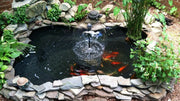
Producing a solar-powered pond is not just a fun DIY job but also a sustainable method to enhance your outside room. Whether you want to bring in wildlife, produce a peaceful water function, or lower your ecological influence, developing a solar-powered fish pond is a wonderful choice. In this guide, we'll stroll you through the step-by-step process of producing your extremely own solar-powered fish pond, from choosing the right solar pump to keeping your fish pond for lasting satisfaction.
Step 1: Selecting the Right Solar Pump

The initial and essential step in developing a solar-powered fish pond is picking the right solar pump. Your pump will certainly be the heart of your pond, circulating water and powering features like water fountains, waterfalls, or oxygenation systems. Here's what to take into consideration when selecting a solar pump:
Pump Power and Dimension
The size of the pump you need will certainly depend on the dimension of your fish pond and the features you intend to include. For smaller-sized fish ponds, a 6.5 W solar pump is excellent, while larger ponds may require something more powerful, such as the 20W solar pump. Make sure to choose a pump that can relocate enough water to keep your fish pond tidy and distribute water efficiently.
Flow Price and Lift
For the best performance, select a pump that matches your fish pond's size and deepness. The flow rate (measured in gallons per hour or GPH) must be sufficient to distribute the water every half an hour to an hour. Furthermore, inspect the lift of the pump, which suggests exactly how high the water can be pumped. For water fountains or waterfalls, you'll need a greater lift.
Photovoltaic Panel Effectiveness
Seek pumps with high-efficiency photovoltaic panels. A mono-crystalline panel like the one on the Poposoap solar pumps offers far better performance in lower light problems, ensuring your pond pump functions even on cloudy days.
Step 2: Setup of Your Solar-Powered Pond

When you've selected the ideal pump, it's time to start with the setup. Below's an easy failure of the steps entailed:
1. Choosing the Location
Find a spot for your fish pond that obtains lots of sunshine throughout the day. This will certainly ensure that your solar panel can bill adequately. Go for a minimum of 6 hours of direct sunshine each day. Bear in mind that the positioning of the photovoltaic panel is just as vital as the location of the fish pond.
2. Establishing the Solar Pump
Once you've located the ideal location, it's time to mount your pump:
· Put the pump: Depending on your pump model, area it at the end of your pond. Make sure it is securely located, and the consumption is clear of debris.
· Set up the photovoltaic panel: The photovoltaic panel must be placed in an area where it will obtain ample sunlight. Usage adjustable installs to position the panel at an angle to enhance sunlight exposure.
· Attach the electrical wiring: Affix the pump's power line to the solar panel. If your pump has a battery backup, comply with the maker's directions for setting up and connecting the battery.
3. Including Water Attributes
Now comes the enjoyable component! You can include a fountain, waterfall, and even an easy water spout to improve the visual appeals of your pond. Utilize the consisted of nozzles to change the height and flow of the water. Several solar pumps included multiple nozzle alternatives that allow you to tailor the water flow.
Step 3: Maintaining Your Solar-Powered Pond
A DIY solar-powered pond calls for some maintenance to keep it running efficiently. Below are some handy suggestions for ensuring your fish pond stays clean, healthy, balanced, and effective:
1. Clean the Solar Panel Consistently
To keep the performance of your solar pump, tidy the photovoltaic panel a minimum of when a month. Dust, dust, and particles can obstruct sunshine and minimize the billing ability. Use a soft towel and light soap to gently clean the panel.
2. Inspect the Pump and Filters
Check your pump for debris or algae build-up, which can obstruct water circulation. Tidy the pump and any type of filters on a regular basis (depending on the pump version, every couple of weeks to a month). You can likewise clean the intake with a brush to keep it clear.
3. Water Top Quality Upkeep
Your fish pond's water quality is critical for the health of both the fish pond and the solar pump. Consider using organic filters and UV sterilizers to help keep the water clear. Including plants to your pond can likewise aid soak up nutrients and maintain the environment well balanced.
4. Winter Care
Throughout wintertime, you may require to bring your pump and photovoltaic panel inside, especially if you stay in an area that experiences freezing temperatures. Storing the devices throughout the cold months will lengthen its life and guarantee it stays in good working order.
Step 4: Why Solar-Powered Fish Ponds are Eco-Friendly
Solar-powered ponds are a green method to boost your garden or landscape. By utilizing solar power, you're not just minimizing your electrical energy expense, but you're additionally adding to a sustainable atmosphere. Solar pumps have a reduced ecological effect, and they assist preserve water by stopping stagnation and algae growth. Plus, solar-powered systems are much easier to preserve than conventional electric pumps, which need more sources to run.
Conclusion
Developing a do-it-yourself solar-powered fish pond is an easy, fun, and eco-friendly method to enhance your garden. From choosing the appropriate solar pump to making certain appropriate upkeep, the actions laid out above will certainly lead you via the process. Not just will you be developing a gorgeous outside oasis, however you'll likewise be doing your component to preserve energy and shield the environment.
If you're aiming to begin on your own solar-powered fish pond, look into our range of solar pond pumps and accessories to discover the ideal suitable for your task. Do not fail to remember to preserve your fish pond on a regular basis for durable satisfaction, and share your DIY pond experiences with us!







